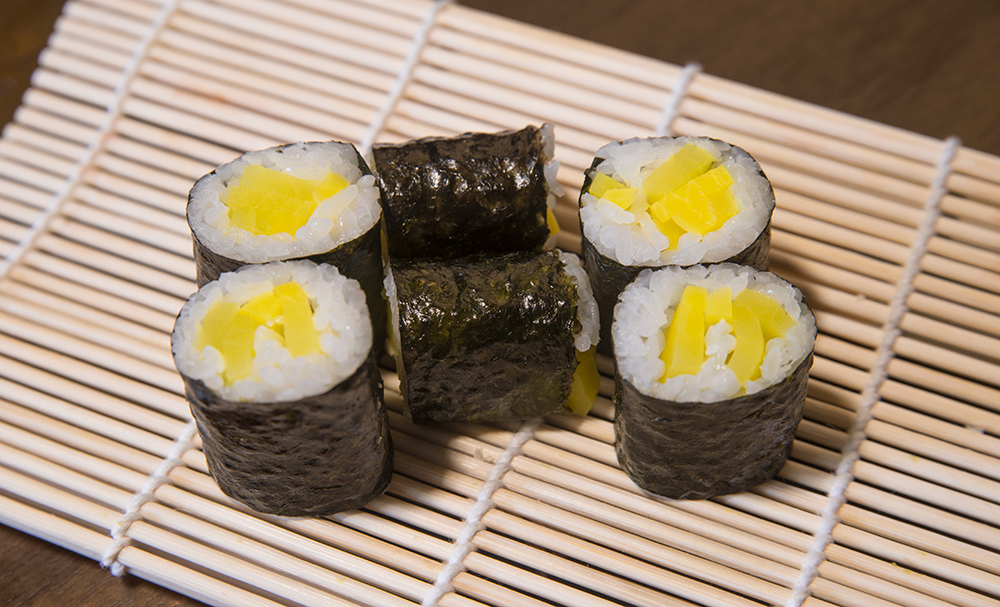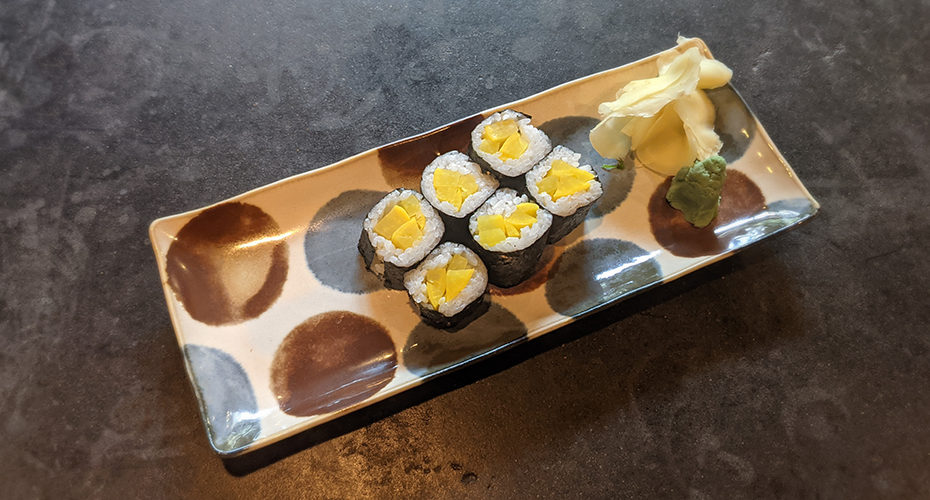The little oshinko roll is one of the best values on a sushi bar menu. But what exactly is an oshinko roll?
It depends on who you ask.
This post will break down this healthy and affordable vegetarian item. Learn about the ingredients of this roll, what it tastes like, nutritional info, and how to make them at home.
What is Oshinko?
Oshinko is a type of Japanese pickle or tsukemono. Many different vegetables are used.
Oshinko (お新香, おしんこ) means “fresh aroma” because they have a short pickling time. It’s also common these days to use oshinko as a broad term for all types of pickles.
Pickled daikon radish is the most common type of oshinko.
Most restaurants and recipes use takuan pickles. These bright yellow daikon pickles weren’t oshinko traditionally because they are fermented over several months. But today, that distinction doesn’t matter. Oshinko is now a catch-all term for pickled veggies.
This oshinko sushi post is part of an informative sushi and sashimi guide. Check it out if you want to take your sushi game pro.
A Little More Info on Takuan
Takuan is a bright yellow, crunchy, and pungent Japanese pickle. It’s arguably the most famous type of pickled daikon.
A 17th-century Buddhist priest named Takuan invented these pickles and introduced them to Japan. Takuan requires months of smelly fermentation. So they’re typically purchased from the store.
Takuan is only made once per year. Daikon is harvested in the fall and hung in the shade for two or three weeks. They’re then pickled in salt for a short amount of time. After that, they’re fermented in more salt and rice bran (nuka) for two to three months.
Once the takuan are fermented, they’ll last up to a year.
It’s common to serve takuan over hot rice. And takuan is also a common ingredient in assorted pickles (tsukemono/oshinko moriawase).

The Oshinko Roll
The oshinko roll is common in sushi restaurants and izakaya in North America and Japan. This sushi roll has a satisfying crunch, a low cost, and is healthy.
Most of the time, oshinko rolls are hosomaki. This is a traditional thin sushi roll with nori seaweed on the outside. It’s usually cut into six pieces.
What Does An Oshinko Roll Taste Like?
The texture of oshinko rolls made with takuan is crunchy and a little springy. They taste sweet, salty, and a little pungent.
Oshinko Roll Ingredients
The oshinko roll, or oshinko maki, is usually made with pickled daikon radish. Sushi rice and nori seaweed are the other two primary ingredients. Oshinko rolls are very simple and are easy to make at home.
As mentioned above, takuan is the most common daikon pickle for oshinko maki. And some restaurants call this a takuan roll instead.
Quick-pickled daikon, gobo, cabbage and carrot, shibazuke, or other pickled veggies may also be used to make oshinko maki.
How to Make Oshinko Maki Sushi
Making an oshinko roll is the same as making other hosomaki. Check out the informative how-to video from TabiEats on making hosomaki at home.
Oshinko Roll Nutritional Info
Oshinko rolls made with takuan are a healthy snack. Takuan, nori seaweed, short-grain white rice, sake vinegar, salt, and sugar are the standard ingredients.
Takuan rolls contain about 140 calories, 33 g of carbs, 3 g of protein, and 600 mg of sodium.
Are Oshinko Roll Vegetarian?
Oshinko maki are usually vegan and vegetarian. However, at restaurants, it’s always good to ask the chef about the ingredients. Oshinko is a broad term for pickles. Sometimes dashi may be used in the recipe. This is rare but worth knowing.
31 Days of Sushi
If you find this post useful or enjoyable, I suggest you check out some of the other content in my 31 Days of Sushi campaign.
Every day in August I’ll share a new piece of content. Topics are centered around nigiri and maki sushi. I include sashimi info, as well.
It’s like an omakase of sushi information!
What Do You Think About Oshinko Maki?
Do you like oshinko rolls, and have you ever made them at home?
Please share your thoughts by commenting below!

Very interesting. I love all the Asian veggies. Love miso raimen. I will try oshinko over white rice…different and flavorful I’m betting!